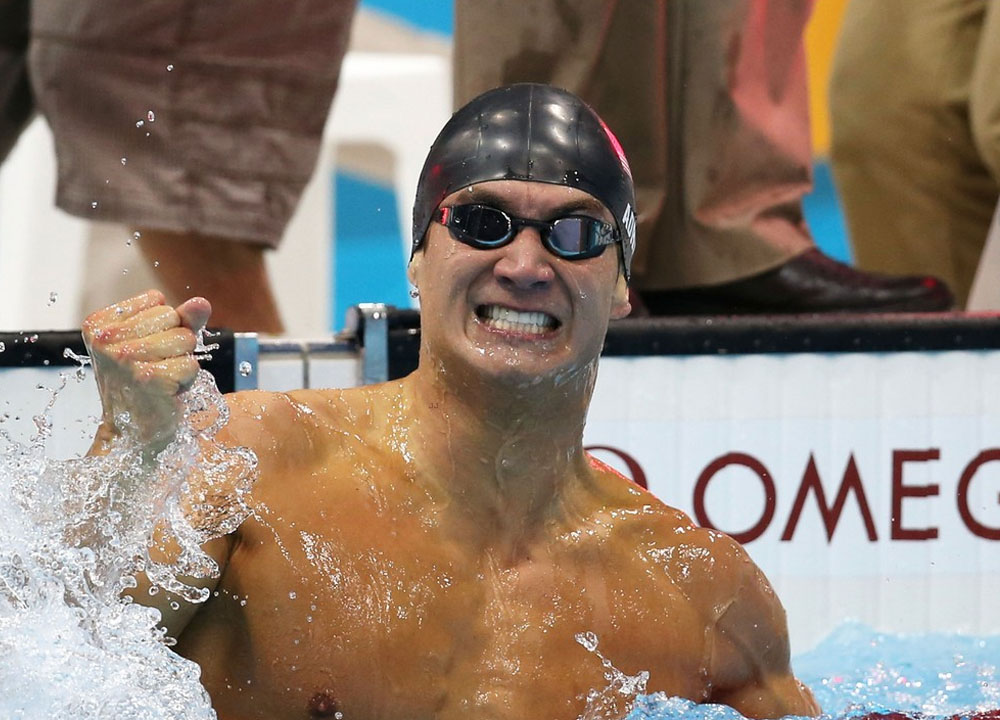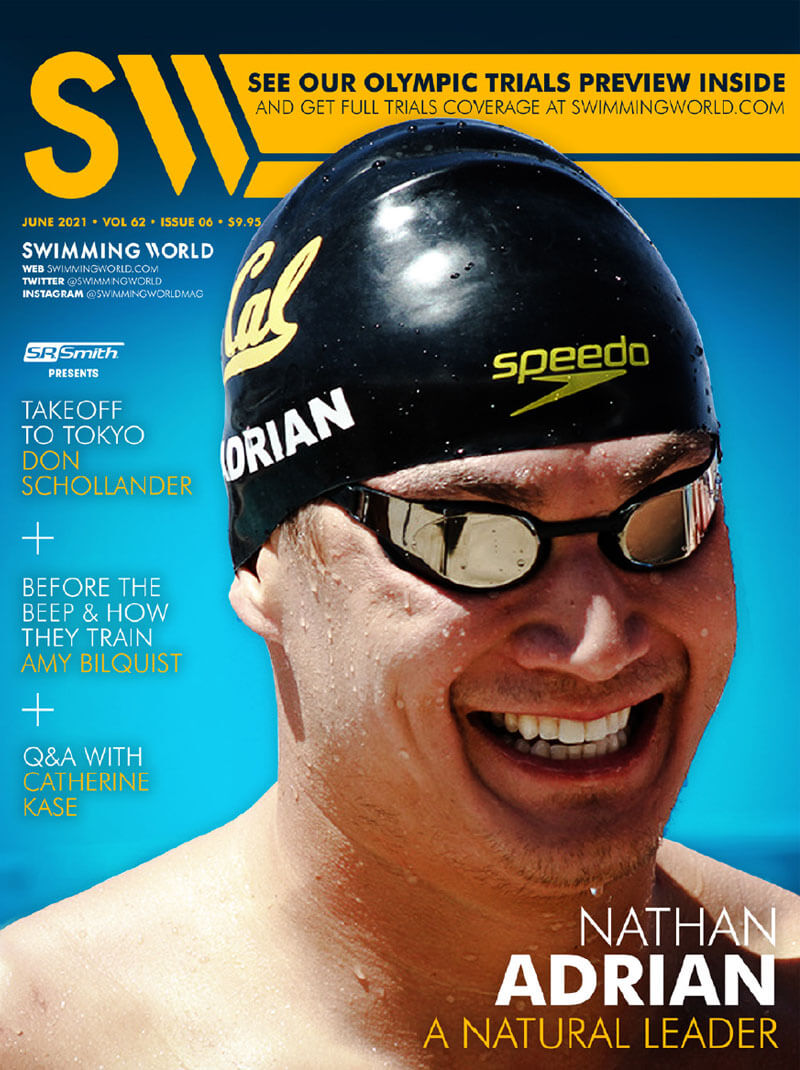Swimming World Presents The June 2021 Cover Feature – Nathan Adrian: A Natural Leader

The latest issue of Swimming World Magazine
is now available for download in the Swimming World Vault!
Non-Subscribers Can Download This Issue Here
Nathan Adrian: A Natural Leader
By John Lohn
Still producing elite-level performances, Nathan Adrian, now 32 and pursuing his fourth Olympic Games, has the opportunity to further his already lofty reputation. And whenever his days in the sport come to an end, Adrian will be viewed for his excellence in the sport as an athlete, teammate and ambassador.
The evolution of Nathan Adrian, a decade-plus development from promise to greatness, can be considered the perfect blueprint for how a Hall of Fame career is molded. Sure, HOF status can be obtained in a variety of ways. Emergence as a phenom. Patience as a late bloomer. Pride in longevity. These are just a few of the paths that can be traveled.
In his march to eventual enshrinement into the International Swimming Hall of Fame, Adrian has basically drafted a flawlessly written How-to-Guide for induction. Consider the steps he has taken:
- As a rising collegiate star at Cal-Berkeley, Adrian qualified for his first Olympic Games in 2008 and left Beijing with a gold medal for his prelim contributions to the United States’ 400 freestyle relay.
- Having established himself as one of America’s premier sprinters over the previous few years, Adrian soared to the top of the world when he captured the Olympic title in the 100 freestyle at the 2012 Games in London. It was an effort complemented by a pair of relay medals, with Adrian handling the anchor role for Team USA.
- From 2013-17, Adrian was the reliable veteran—and team leader—at all international competitions, with four medals earned at the 2016 Olympics in Rio de Janeiro and nine medals claimed from the World Championships.
Now, as a 32-year-old, Adrian is chasing his fourth Olympic berth and seeking to further his reputation as one of history’s elite sprinters. As he looks to write this next chapter, Adrian will try to deny the next realm of stars while having experienced life’s highs and lows.
A TOKYO TICKET?
The gauntlet that is the United States Olympic Trials is nothing like any other qualifying event in the world. As impressive as the depth may be in certain events around the world, no nation measures up to the American arsenal. This fact is hardly an unknown, for the United States has long left home medal-contending talent from the Olympic Games.
As Adrian prepares for his fourth Trials, he is aware that the sprint-freestyle events, specifically the 100 freestyle, are loaded. It can be argued that the 100 free is the deepest event on the men’s program. While two-time defending world champion Caeleb Dressel is viewed as a lock to secure one of the two Tokyo bids in the event, a plethora of names—including Adrian—are in the mix for the second individual berth, and one of the relay slots available.
How fast will the field be at Trials in Omaha? It is possible that a sub-48 performance will be required to qualify for the final. To put that type of speed in perspective, outside of the farcical 2009 World Championships (ruled by super suits), there has never been an international final featuring a full field of sub-48 qualifiers.
In addition to Dressel, Adrian will duel with the likes of Blake Pieroni, Zach Apple, Maxime Rooney and Ryan Held, among others.
“It is an impressive field,” Adrian said. “I feel like I’m a backstroker. Team USA has been stacked in the backstroke since the 1970s, and freestyle has not necessarily been that way. But the last few years, it has really developed, and it may take a 47 (to final). There’s nothing I can do about it. My mentality is do what I can do.”
On top of the 100 freestyle, Adrian will again be a lead contender in the 50 freestyle, where Dressel has won back-to-back world titles. In the one lap sprint, Adrian figures to battle with the likes of Michael Andrew, Held, Apple and rising star David Curtiss.
Originally preparing for Trials in 2020, before the COVID-19 pandemic necessitated a one-year delay of the Olympic Games, Adrian and longtime coach Dave Durden carefully designed a training regimen. As an athlete in his 30s, Adrian doesn’t recover as quickly as he did in the past. Consequently, practices are either tweaked or Adrian eases off the pedal when his body informs him of the need.
More, Adrian is drawing on his experience with a lighter meet schedule. Although USA Swimming has offered several TYR Pro Series competitions, Adrian will enter Trials with a lighter racing load. That scenario might prove hazardous for younger athletes, but Adrian knows what to expect and how to handle multiple rounds of racing and the intense pressure that will be present.
“The volume I’m doing is not what it used to be,” Adrian said. “I would say I’m doing half a practice less each week. It lets me recover. There’s a self-awareness. I have a trust in (Durden), and he knows I’m going to put in the effort.”
To access the complete article on Nathan Adrian and his path to Tokyo,
Click here to download the full June 2021 Issue of Swimming World, available now!
Get Swimming World Magazine and Swimming World Biweekly FREE When You
Become A Member of the International Swimming Hall of Fame
New! 30 Day Membership to ISHOF AND Digital Swimming World Subscription for just $10 a month!
Want more? Get a 1 Year ISHOF Family Membership With Swimming World Print AND Digital Subscription Order Now!
Non-Subscribers can click here to download this issue for only $5.94
Swimming World June 2021 Issue
FEATURES
12 | U.S. OLYMPIC TRIALS PREVIEW
by David Rieder
The fastest swimmers in the United States will be putting their hopes and dreams on the line at the U.S. Olympic Team Trials-Swimming, June 13-20, in Omaha, Neb. If realized, they’ll have the opportunity to perform next month on the world’s grandest stage: the Olympic Games in Tokyo.
22 | A NATURAL LEADER
by John Lohn
Still producing elite-level performances, Nathan Adrian, now 32 and pursuing his fourth Olympic Games, has the opportunity to further his already lofty reputation. And whenever his days in the sport come to an end, Adrian will be viewed for his excellence in the sport as an athlete, teammate and ambassador.
25 | NJCAA CHAMPIONSHIPS: QUALITY & QUANTITY
by Andy Ross
That’s the same winning formula that Indian River’s men’s and women’s swimming and diving teams have been using for nearly a half-century at the NJCAA Championships. The Pioneer men now have won 47 straight team titles; the women, 39—and 43 of the past 47.
26 | TAKEOFF TO TOKYO: A FORGOTTEN STAR
by John Lohn
By all measures, Don Schollander is a legend in the sport, a Hall of Fame talent who was unrivaled in his heyday. Yet, his impact has been lost to a combination of unfortunate timing and modern-day fascination.
29 | DOMINANCE AND PARITY ON DISPLAY IN TOKYO
by Dan D’Addona
While the U.S. women have dominated international water polo since 2015—winning their second straight Olympics in 2016 plus three World Championships in 2015-17-19—a different men’s champion has emerged at each of the last three major international competitions—Serbia (2016 Olympics), Croatia (2017 Worlds) and Italy (2019 Worlds).
30 | ISHOF: REMEMBERING THE KALILI BROTHERS—90 YEARS AGO
by Bruce Wigo
As kids who preferred to dive for coins rather than race in a swimming pool, brothers Maiola and Manuella Kalili from Hawaii would eventually become national champions and Olympic silver medalists in 1932.
33 | NUTRITION: HOW MANY CALORIES SHOULD I EAT?
by Dawn Weatherwax
As long course, Olympics and endurance events get underway, a common question is: “How much do I need to eat?” This is a loaded question—one in which the author will try to simplify.
35 | MENTAL PREP: BEFORE THE BEEP WITH AMY BILQUIST
by Shoshanna Rutemiller
COACHING
38 | SWIMMING TECHNIQUE CONCEPTS: MAXIMIZING SWIMMING VELOCITY (Part 2)—STROKE CYCLE PHASES
by Rod Havriluk
Swimmers typically decrease non-propulsive time to decrease stroke time, increase stroke rate and swim faster. Research shows that a further decrease in the non-propulsive time is possible and should produce further performance improvement.
40 | A COACHES’ GUIDE TO ENERGY SYSTEMS
by Michael J. Stott
In the first of two parts, Swimming World explores the concept of energy systems and how coaches can use them to maximize athlete development and performance.
42 | SPECIAL SETS: KATIE LEDECKY—RUN-UP TO RIO 2016
by Michael J. Stott
With this month’s Olympic Swimming Trials now upon us, Swimming World takes a back-to-the-future approach to revisit some training done by superstar Katie Ledecky prior to the 2016 U.S. team qualifying meet.
44 | Q&A WITH COACH CATHERINE KASE
by Michael J. Stott
45 | HOW THEY TRAIN HALEY ANDERSON
by Michael J. Stott
TRAINING
037 | DRYSIDE TRAINING: TRAINING AMY BILQUIST
by J.R. Rosania
JUNIOR SWIMMER
47 | UP & COMERS: KEELAN COTTER
by Shoshanna Rutemiller
COLUMNS
08 | A VOICE FOR THE SPORT
11 | DID YOU KNOW: ABOUT BUSTER CRABBE?
48 | GUTTERTALK
49 | PARTING SHOT
Swimming World is now partnered with the International Swimming Hall of Fame. To find out more, visit us at ishof.org




